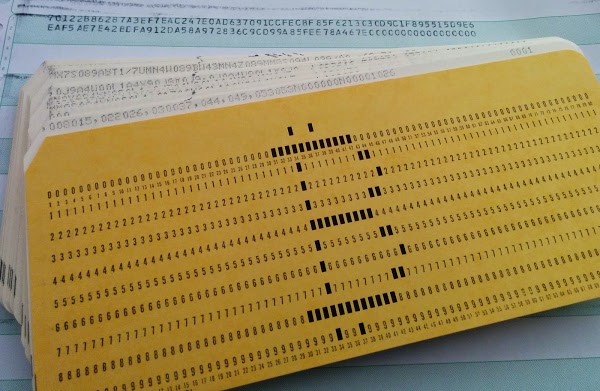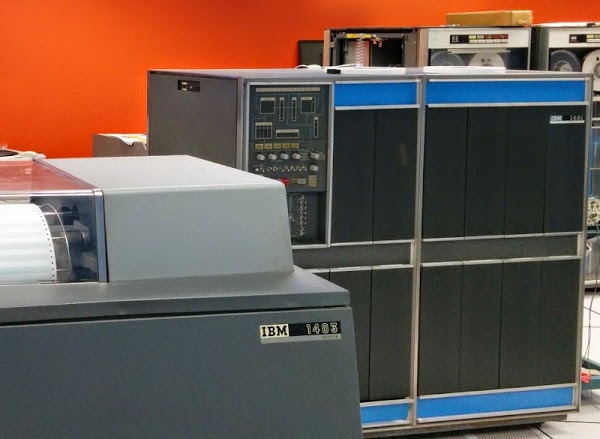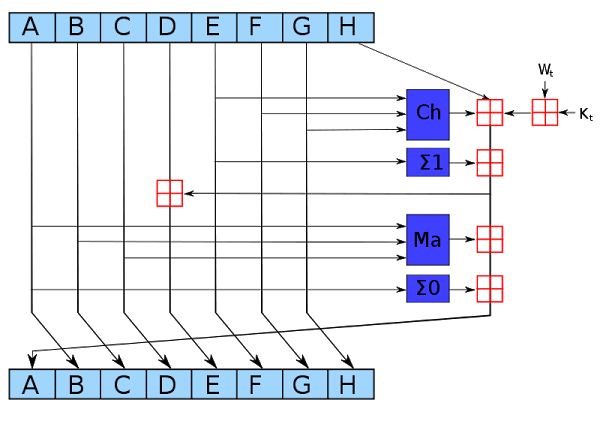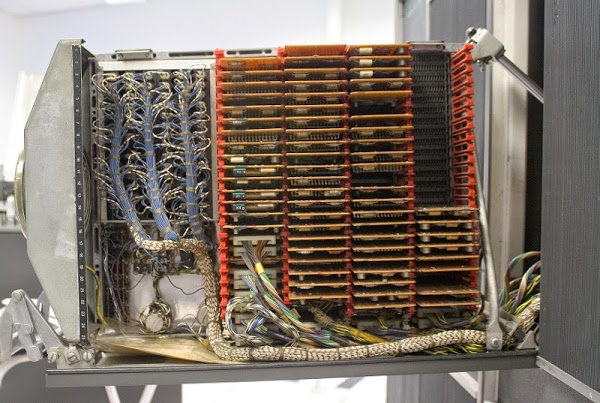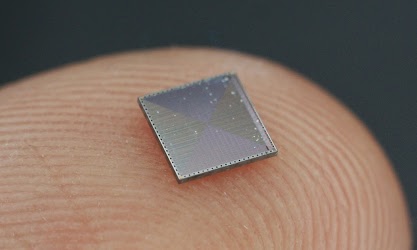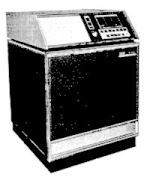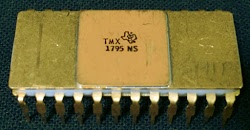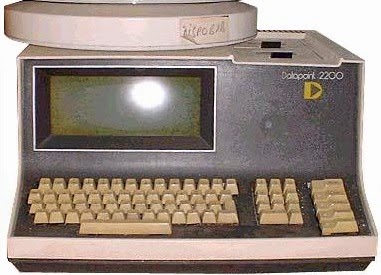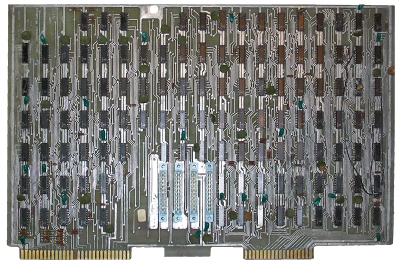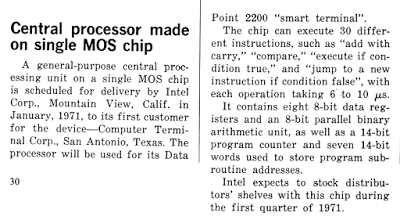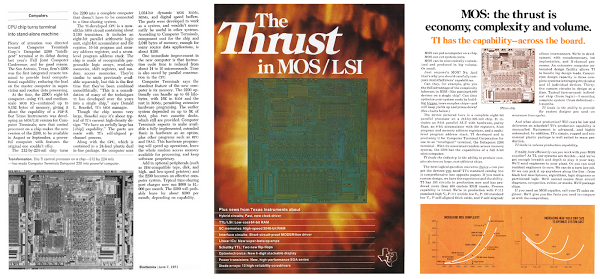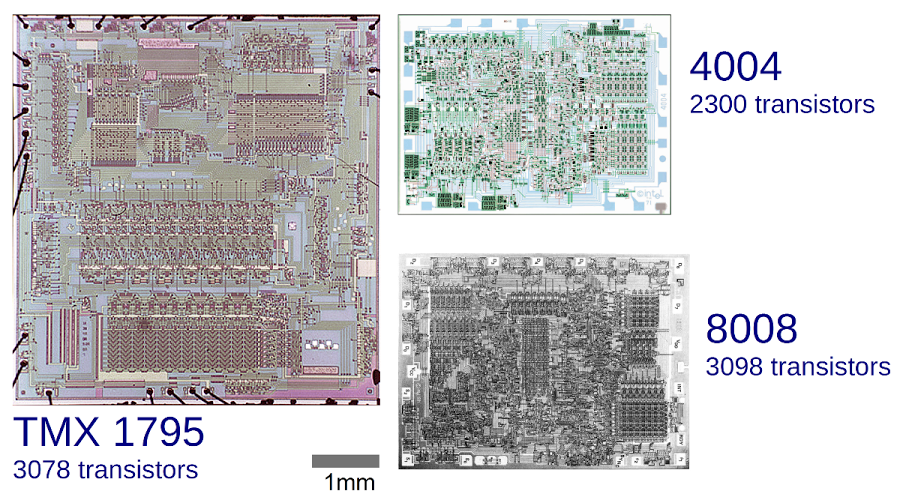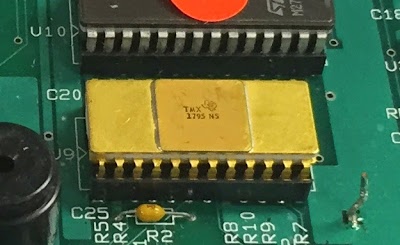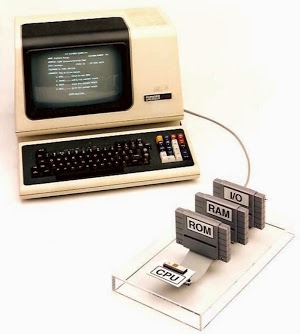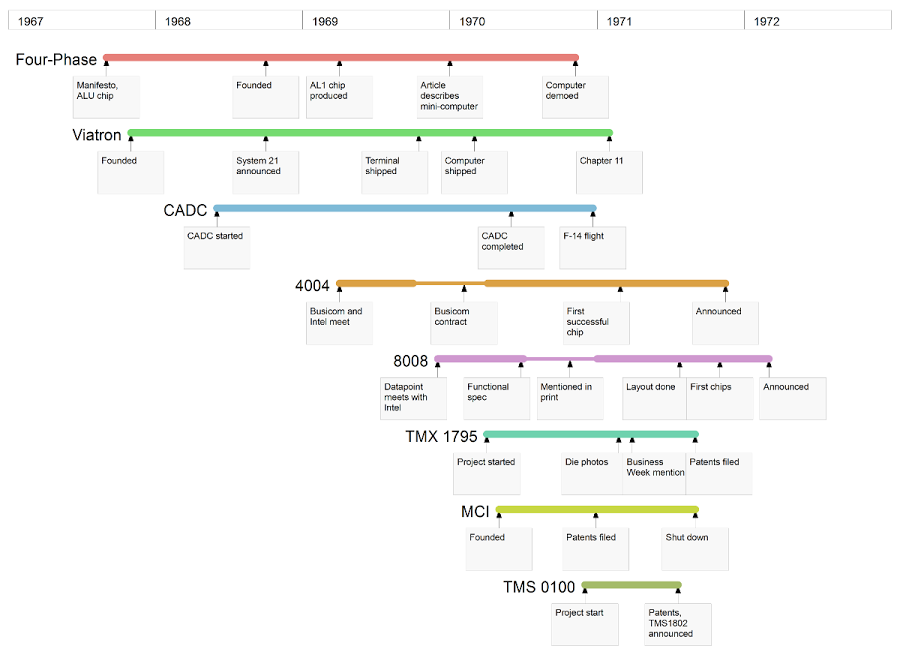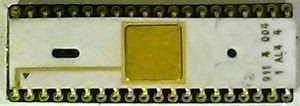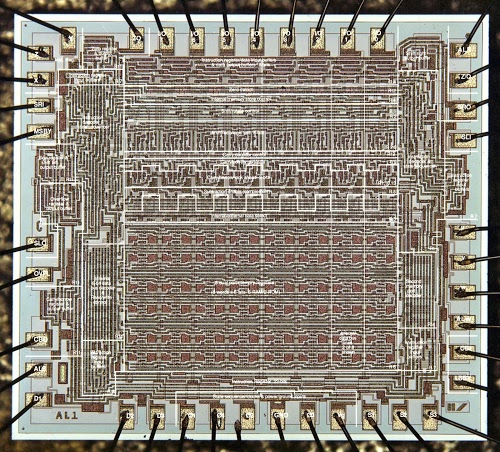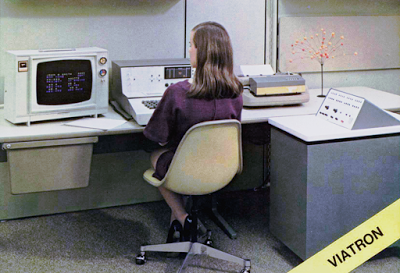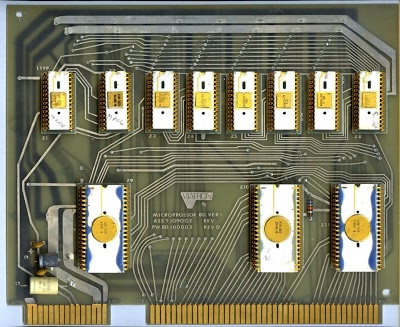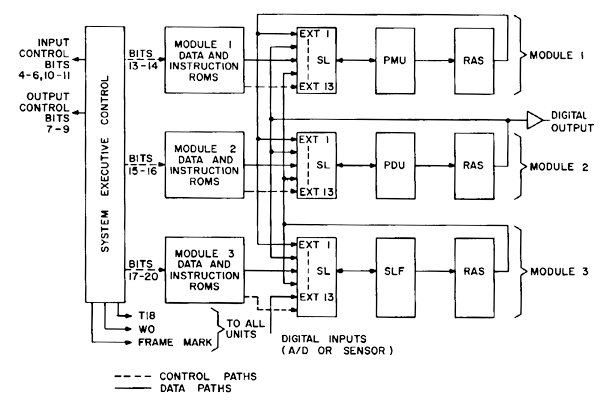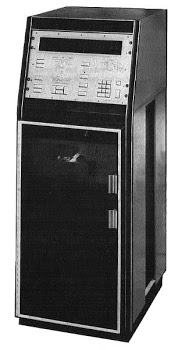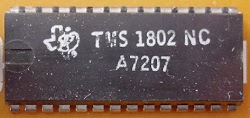The photo below shows the card deck I used, along with the output of my SHA-256 hash program as printed by the line printer. (The card on the front of the deck is just for decoration; it was a huge pain to punch.) Note that the second line of output ends with a bunch of zeros; this indicates a successful hash.
How Bitcoin mining works
Bitcoin, a digital currency that can be transmitted across the Internet, has attracted a lot of attention lately. If you're not familiar with how it works, the Bitcoin system can be thought of as a ledger that keeps track of who owns which bitcoins, and allows them to be transferred from one person to another. The interesting thing about Bitcoin is there's no central machine or authority keeping track of things. Instead, the records are spread across thousands of machines on the Internet.The difficult problem with a distributed system like this is how to ensure everyone agrees on the records, so everyone agrees if a transaction is valid, even in the presence of malicious users and slow networks. The solution in Bitcoin is a process called mining—about every 10 minutes a block of outstanding transactions is mined, which makes the block official.
To prevent anyone from controlling which transactions are mined, the mining process is very difficult and competitive. In particular a key idea of Bitcoin is that mining is made very, very difficult, a technique called proof-of-work. It takes an insanely huge amount of computational effort to mine a block, but once a block has been mined, it is easy for peers on the network to verify that a block has been successfully mined. The difficulty of mining keeps anyone from maliciously taking over Bitcoin, and the ease of checking that a block has been mined lets users know which transactions are official.
As a side-effect, mining adds new bitcoins to the system. For each block mined, miners currently get 25 new bitcoins (currently worth about $6,000), which encourages miners to do the hard work of mining blocks. With the possibility of receiving $6,000 every 10 minutes, there is a lot of money in mining and people invest huge sums in mining hardware.
Mining requires a task that is very difficult to perform, but easy to verify. Bitcoin mining uses cryptography, with a hash function called double SHA-256. A hash takes a chunk of data as input and shrinks it down into a smaller hash value (in this case 256 bits). With a cryptographic hash, there's no way to get a hash value you want without trying a whole lot of inputs. But once you find an input that gives the value you want, it's easy for anyone to verify the hash. Thus, cryptographic hashing becomes a good way to implement the Bitcoin "proof-of-work".
In more detail, to mine a block, you first collect the new transactions into a block. Then you hash the block to form an (effectively random) block hash value. If the hash starts with 16 zeros, the block is successfully mined and is sent into the Bitcoin network. Most of the time the hash isn't successful, so you modify the block slightly and try again, over and over billions of times. About every 10 minutes someone will successfully mine a block, and the process starts over. It's kind of like a lottery, where miners keep trying until someone "wins". It's hard to visualize just how difficult the hashing process is: finding a valid hash is less likely than finding a single grain of sand out of all the sand on Earth. To find these hashes, miners have datacenters full of specialized hardware to do this mining.
I've simplified a lot of details. For in-depth information on Bitcoin and mining, see my articles Bitcoins the hard way and Bitcoin mining the hard way.
The SHA-256 hash algorithm used by Bitcoin
Next, I'll discuss the hash function used in Bitcoin, which is based on a standard cryptographic hash function called SHA-256. Bitcoin uses "double SHA-256" which simply applies the SHA-256 function twice. The SHA-256 algorithm is so simple you can literally do it by hand, but it manages to scramble the data entirely unpredictably. The algorithm takes input blocks of 64 bytes, combines the data cryptographically, and generates a 256-bit (32 byte) output. The algorithm uses a simple round and repeats it 64 times. The diagram below shows one round, which takes eight 4-byte inputs, A through H, performs a few operations, and generates new values for A through H.
The dark blue boxes mix up the values in non-linear ways that are hard to analyze cryptographically. (If you could figure out a mathematical shortcut to generate successful hashes, you could take over Bitcoin mining.) The Ch "choose" box chooses bits from F or G, based on the value of input E. The Σ "sum" boxes rotate the bits of A (or E) to form three rotated versions, and then sums them together modulo 2. The Ma "majority" box looks at the bits in each position of A, B, and C, and selects 0 or 1, whichever value is in the majority. The red boxes perform 32-bit addition, generating new values for A and E. The input Wt is based on the input data, slightly processed. (This is where the input block gets fed into the algorithm.) The input Kt is a constant defined for each round.
As can be seen from the diagram above, only A and E are changed in a round. The other values pass through unchanged, with the old A value becoming the new B value, the old B value becoming the new C value and so forth. Although each round of SHA-256 doesn't change the data much, after 64 rounds the input data will be completely scrambled, generating the unpredictable hash output.
The IBM 1401
I decided to implement this algorithm on the IBM 1401 mainframe. This computer was announced in 1959, and went on to become the best-selling computer of the mid-1960s, with more than 10,000 systems in use. The 1401 wasn't a very powerful computer even for 1960, but since it leased for the low price of $2500 a month, it made computing possible for mid-sized businesses that previously couldn't have afforded a computer.The IBM 1401 didn't use silicon chips. In fact it didn't even use silicon. Its transistors were built out of a semiconductor called germanium, which was used before silicon took over. The transistors and other components were mounted on boards the size of playing cards called SMS cards. The computer used thousands of these cards, which were installed in racks called "gates". The IBM 1401 had a couple dozen of these gates, which folded out of the computer for maintenance. Below, one of the gates is opened up showing the circuit boards and cabling.
Internally, the computer was very different from modern computers. It didn't use 8-bit bytes, but 6-bit characters based on binary coded decimal (BCD). Since it was a business machine, the computer used decimal arithmetic instead of binary arithmetic and each character of storage held a digit, 0 through 9. The computer came with 4000 characters of storage in magnetic core memory; a dishwasher-sized memory expansion box provided 12,000 more characters of storage. The computer was designed to use punched cards as input, with a card reader that read the program and data. Output was printed on a fast line printer or could be punched on more cards.
The Computer History Museum in Mountain View has two working IBM 1401 mainframes. I used one of them to run the SHA-256 hash code. For more information on the IBM 1401, see my article Fractals on the IBM 1401.
Implementing SHA-256 on the IBM 1401
The IBM 1401 is almost the worst machine you could pick to implement the SHA-256 hash algorithm. The algorithm is designed to be implemented efficiently on machines that can do bit operations on 32-bit words. Unfortunately, the IBM 1401 doesn't have 32-bit words or even bytes. It uses 6-bit characters and doesn't provide bit operations. It doesn't even handle binary arithmetic, using decimal arithmetic instead. Thus, implementing the algorithm on the 1401 is slow and inconvenient.I ended up using one character per bit. A 32-bit value is stored as 32 characters, either "0" or "1". My code has to perform the bit operations and additions character-by-character, basically checking each character and deciding what to do with it. As you might expect, the resulting code is very slow.
The assembly code I wrote is below. The comments should give you a rough idea of how the code works. Near the end of the code, you can see the table of constants required by the SHA-256 algorithm, specified in hex. Since the 1401 doesn't support hex, I had to write my own routines to convert between hex and binary. I won't try to explain IBM 1401 assembly code here, except to point out that it is very different from modern computers. It doesn't even have subroutine calls and returns. Operations happen on memory, as there aren't any general-purpose registers.
job bitcoin
* SHA-256 hash
* Ken Shirriff //righto.com
ctl 6641
org 087
X1 dcw @000@
org 092
X2 dcw @000@
org 097
X3 dcw @000@
org 333
start cs 299
r
sw 001
lca 064, input0
mcw 064, 264
w
* Initialize word marks on storage
mcw +s0, x3
wmloop sw 0&x3
ma @032@, x3
c +h7+32, x3
bu wmloop
mcw +input-127, x3 * Put input into warr[0] to warr[15]
mcw +warr, x1
mcw @128@, tobinc
b tobin
* Compute message schedule array w[0..63]
mcw @16@, i
* i is word index 16-63
* x1 is start of warr[i-16], i.e. bit 0 (bit 0 on left, bit 31 on right)
mcw +warr, x1
wloop c @64@, i
be wloopd
* Compute s0
mcw +s0, x2
za +0, 31&x2 * Zero s0
* Add w[i-15] rightrotate 7
sw 7&x2 * Wordmark at bit 7 (from left) of s0
a 56&x1, 31&x2 * Right shifted: 32+31-7 = bit 24 of w[i-15], 31 = end of s0
a 63&x1, 6&x2 * Wrapped: 32+31 = end of w[i-15], 7-1 = bit 6 of s0
cw 7&x2 * Clear wordmark
* Add w[i-15] rightrotate 18
sw 18&x2 * Wordmark at bit 18 (from left) of s0
a 45&x1, 31&x2 * Right shifted: 32+31-18 = bit 13 of w[i-15], 31 = end of s0
a 63&x1, 17&x2 * Wrapped: 32+31 = end of w[i-15], 18-1 = bit 17 of s0
cw 18&x2 * Clear wordmark
* Add w[i-15] rightshift 3
sw 3&x2 * Wordmark at bit 3 (from left) of s0
a 60&x1, 31&x2 * Right shifted: 32+31-3 = bit 28 of w[i-15], 31 = end of s0
cw 3&x2 * Clear wordmark
* Convert sum to xor
mcw x1, x1tmp
mcw +s0+31, x1 * x1 = right end of s0
mcw @032@, x2 * Process 32 bits
b xor
sw s0 * Restore wordmark cleared by xor
mcw x1tmp, x1
* Compute s1
mcw +s1, x2
za +0, 31&x2 * Zero s1
* Add w[i-2] rightrotate 17
sw 17&x2 * Wordmark at bit 17 (from left) of s1
a 462&x1, 31&x2 * Right shifted: 14*32+31-17 = bit 14 of w[i-2], 31 = end of s1
a 479&x1, 16&x2 * Wrapped: 14*32+31 = end of w[i-2], 17-1 = bit 16 of s1
cw 17&x2 * Clear wordmark
* Add w[i-2] rightrotate 19
sw 19&x2 * Wordmark at bit 19 (from left) of s1
a 460&x1, 31&x2 * Right shifted: 14*32+31-19 = bit 12 of w[i-2], 31 = end of s1
a 479&x1, 18&x2 * Wrapped: 14*32+31 = end of w[i-2], 19-1 = bit 18 of s1
cw 19&x2 * Clear wordmark
* Add w[i-2] rightshift 10
sw 10&x2 * Wordmark at bit 10 (from left) of s1
a 469&x1, 31&x2 * Right shifted: 14*32+31-10 = bit 21 of w[i-2], 31 = end of s1
cw 10&x2 * Clear wordmark
* Convert sum to xor
mcw +s1+31, x1 * x1 = right end of s1
mcw @032@, x2 * Process 32 bits
b xor
sw s1 * Restore wordmark cleared by xor
* Compute w[i] := w[i-16] + s0 + w[i-7] + s1
mcw x1tmp, x1
a s1+31, s0+31 * Add s1 to s0
a 31&x1, s0+31 * Add w[i-16] to s0
a 319&x1, s0+31 * Add 9*32+31 = w[i-7] to s0
* Convert bit sum to 32-bit sum
mcw +s0+31, x1 * x1 = right end of s0
mcw @032@, x2 * Process 32 bits
b sum
sw s0 * Restore wordmark cleared by sum
mcw x1tmp, x1
mcw s0+31, 543&x1 * Move s0 to w[i]
ma @032@, x1
a +1, i
mz @0@, i
b wloop
x1tmp dcw #5
* Initialize: Copy hex h0init-h7init into binary h0-h7
wloopd mcw +h0init-7, x3
mcw +h0, x1
mcw @064@, tobinc * 8*8 hex digits
b tobin
* Initialize a-h from h0-h7
mcw @000@, x1
ilp mcw h0+31&x1, a+31&x1
ma @032@, x1
c x1, @256@
bu ilp
mcw @000@, bitidx * bitidx = i*32 = bit index
mcw @000@, kidx * kidx = i*8 = key index
* Compute s1 from e
mainlp mcw +e, x1
mcw +s1, x2
za +0, 31&x2 * Zero s1
* Add e rightrotate 6
sw 6&x2 * Wordmark at bit 6 (from left) of s1
a 25&x1, 31&x2 * Right shifted: 31-6 = bit 25 of e, 31 = end of s1
a 31&x1, 5&x2 * Wrapped: 31 = end of e, 6-1 = bit 5 of s1
cw 6&x2 * Clear wordmark
* Add e rightrotate 11
sw 11&x2 * Wordmark at bit 11 (from left) of s1
a 20&x1, 31&x2 * Right shifted: 31-11 = bit 20 of e, 31 = end of s1
a 31&x1, 10&x2 * Wrapped: 31 = end of e, 11-1 = bit 10 of s1
cw 11&x2 * Clear wordmark
* Add e rightrotate 25
sw 25&x2 * Wordmark at bit 25 (from left) of s1
a 6&x1, 31&x2 * Right shifted: 31-25 = bit 6 of e, 31 = end of s1
a 31&x1, 24&x2 * Wrapped: 31 = end of e, 25-1 = bit 24 of s1
cw 25&x2 * Clear wordmark
* Convert sum to xor
mcw +s1+31, x1 * x1 = right end of s1
mcw @032@, x2 * Process 32 bits
b xor
sw s1 * Restore wordmark cleared by xor
* Compute ch: choose function
mcw @000@, x1 * x1 is index from 0 to 31
chl c e&x1, @0@
be chzero
mn f&x1, ch&x1 * for 1, select f bit
b chincr
chzero mn g&x1, ch&x1 * for 0, select g bit
chincr a +1, x1
mz @0@, x1
c @032@, x1
bu chl
* Compute temp1: k[i] + h + S1 + ch + w[i]
cs 299
mcw +k-7, x3 * Convert k[i] to binary in temp1
ma kidx, x3
mcw +temp1, x1
mcw @008@, tobinc * 8 hex digits
b tobin
mcw @237@, x3
mcw +temp1, x1
mcw @008@, tobinc
b tohex
a h+31, temp1+31 * +h
a s1+31, temp1+31 * +s1
a ch+31, temp1+31 * +ch
mcw bitidx, x1
a warr+31&x1, temp1+31 * + w[i]
* Convert bit sum to 32-bit sum
mcw +temp1+31, x1 * x1 = right end of temp1
b sum
* Compute s0 from a
mcw +a, x1
mcw +s0, x2
za +0, 31&x2 * Zero s0
* Add a rightrotate 2
sw 2&x2 * Wordmark at bit 2 (from left) of s0
a 29&x1, 31&x2 * Right shifted: 31-2 = bit 29 of a, 31 = end of s0
a 31&x1, 1&x2 * Wrapped: 31 = end of a, 2-1 = bit 1 of s0
cw 2&x2 * Clear wordmark
* Add a rightrotate 13
sw 13&x2 * Wordmark at bit 13 (from left) of s0
a 18&x1, 31&x2 * Right shifted: 31-13 = bit 18 of a, 31 = end of s0
a 31&x1, 12&x2 * Wrapped: 31 = end of a, 13-1 = bit 12 of s0
cw 13&x2 * Clear wordmark
* Add a rightrotate 22
sw 22&x2 * Wordmark at bit 22 (from left) of s0
a 9&x1, 31&x2 * Right shifted: 31-22 = bit 9 of a, 31 = end of s0
a 31&x1, 21&x2 * Wrapped: 31 = end of a, 22-1 = bit 21 of s0
cw 22&x2 * Clear wordmark
* Convert sum to xor
mcw +s0+31, x1 * x1 = right end of s0
mcw @032@, x2 * Process 32 bits
b xor
sw s0 * Restore wordmark cleared by xor
* Compute maj(a, b, c): majority function
za +0, maj+31
a a+31, maj+31
a b+31, maj+31
a c+31, maj+31
mz @0@, maj+31
mcw @000@, x1 * x1 is index from 0 to 31
mjl c maj&x1, @2@
bh mjzero
mn @1@, maj&x1 * majority of the 3 bits is 1
b mjincr
mjzero mn @0@, maj&x1 * majority of the 3 bits is 0
mjincr a +1, x1
mz @0@, x1
c @032@, x1
bu mjl
* Compute temp2: S0 + maj
za +0, temp2+31
a s0+31, temp2+31
a maj+31, temp2+31
* Convert bit sum to 32-bit sum
mcw +temp2+31, x1 * x1 = right end of temp1
b sum
mcw g+31, h+31 * h := g
mcw f+31, g+31 * g := f
mcw e+31, f+31 * f := e
za +0, e+31 * e := d + temp1
a d+31, e+31
a temp1+31, e+31
mcw +e+31, x1 * Convert sum to 32-bit sum
b sum
mcw c+31, d+31 * d := c
mcw b+31, c+31 * c := b
mcw a+31, b+31 * b := a
za +0, a+31 * a := temp1 + temp2
a temp1+31, a+31
a temp2+31, a+31
mcw +a+31, x1 * Convert sum to 32-bit sum
b sum
a @8@, kidx * Increment kidx by 8 chars
mz @0@, kidx
ma @032@, bitidx * Increment bitidx by 32 bits
c @!48@, bitidx * Compare to 2048
bu mainlp
* Add a-h to h0-h7
cs 299
mcw @00000@, x1tmp
add1 mcw x1tmp, x1
a a+31&x1, h0+31&x1
ma +h0+31, x1 * Convert sum to 32-bit sum
b sum
ma @032@, x1tmp
c @00256@, x1tmp
bu add1
mcw @201@, x3
mcw +h0, x1
mcw @064@, tobinc
b tohex
w
mcw 280, 180
p
p
finis h
b finis
* Converts sum of bits to xor
* X1 is right end of word
* X2 is bit count
* Note: clears word marks
xor sbr xorx&3
xorl c @000@, x2
be xorx
xorfix mz @0@, 0&x1 * Clear zone
c 0&x1, @2@
bh xorok
sw 0&x1 * Subtract 2 and loop
s +2, 0&x1
cw 0&x1
b xorfix
xorok ma @I9I@, x1 * x1 -= 1
s +1, x2 * x2 -= 1
mz @0@, x2
b xorl * loop
xorx b @000@
* Converts sum of bits to sum (i.e. propagate carries if digit > 1)
* X1 is right end of word
* Ends at word mark
sum sbr sumx&3
suml mz @0@, 0&x1 * Clear zone
c 0&x1, @2@ * If digit is <2, then ok
bh sumok
s +2, 0&x1 * Subtract 2 from digit
bwz suml, 0&x1, 1 * Skip carry if at wordmark
a @1@, 15999&x1 * Add 1 to previous position
b suml * Loop
sumok bwz sumx,0&x1,1 * Quit if at wordmark
ma @I9I@, x1 * x1 -= 1
b suml * loop
sumx b @000@ * return
* Converts binary to string of hex digits
* X1 points to start (left) of binary
* X3 points to start (left) of hex buffer
* X1, X2, X3 destroyed
* tobinc holds count (# of hex digits)
tohex sbr tohexx&3
tohexl c @000@, tobinc * check counter
be tohexx
s @1@, tobinc * decrement counter
mz @0@, tobinc
b tohex4
mcw hexchr, 0&x3
ma @004@, X1
ma @001@, X3
b tohexl * loop
tohexx b @000@
* X1 points to 4 bits
* Convert to hex char and write into hexchr
* X2 destroyed
tohex4 sbr tohx4x&3
mcw @000@, x2
c 3&X1, @1@
bu tohx1
a +1, x2
tohx1 c 2&X1, @1@
bu tohx2
a +2, x2
tohx2 c 1&x1, @1@
bu tohx4
a +4, x2
tohx4 c 0&x1, @1@
bu tohx8
a +8, x2
tohx8 mz @0@, x2
mcw hextab-15&x2, hexchr
tohx4x b @000@
* Converts string of hex digits to binary
* X3 points to start (left) of hex digits
* X1 points to start (left) of binary digits
* tobinc holds count (# of hex digits)
* X1, X3 destroyed
tobin sbr tobinx&3
tobinl c @000@, tobinc * check counter
be tobinx
s @1@, tobinc * decrement counter
mz @0@, tobinc
mcw 0&X3, hexchr
b tobin4 * convert 1 char
ma @004@, X1
ma @001@, X3
b tobinl * loop
tobinx b @000@
tobinc dcw @000@
* Convert hex digit to binary
* Digit in hexchr (destroyed)
* Bits written to x1, ..., x1+3
tobin4 sbr tobn4x&3
mcw @0000@, 3+x1 * Start with zero bits
bwz norm,hexchr,2 * Branch if no zone
mcw @1@, 0&X1
a @1@, hexchr * Convert letter to value: A (1) -> 2, F (6) -> 7
mz @0@, hexchr
b tob4
norm c @8@, hexchr
bl tob4
mcw @1@, 0&X1
s @8@, hexchr
mz @0@, hexchr
tob4 c @4@, hexchr
bl tob2
mcw @1@, 1&X1
s @4@, hexchr
mz @0@, hexchr
tob2 c @2@, hexchr
bl tob1
mcw @1@, 2&X1
s @2@, hexchr
mz @0@, hexchr
tob1 c @1@, hexchr
bl tobn4x
mcw @1@, 3&X1
tobn4x b @000@
* Message schedule array is 64 entries of 32 bits = 2048 bits.
org 3000
warr equ 3000
s0 equ warr+2047 *32 bits
s1 equ s0+32
ch equ s1+32 *32 bits
temp1 equ ch+32 *32 bits
temp2 equ temp1+32 *32 bits
maj equ temp2+32 *32 bits
a equ maj+32
b equ a+32
c equ b+32
d equ c+32
e equ d+32
f equ e+32
g equ f+32
h equ g+32
h0 equ h+32
h1 equ h0+32
h2 equ h1+32
h3 equ h2+32
h4 equ h3+32
h5 equ h4+32
h6 equ h5+32
h7 equ h6+32
org h7+32
hexchr dcw @0@
hextab dcw @0123456789abcdef@
i dcw @00@ * Loop counter for w computation
bitidx dcw #3
kidx dcw #3
* 64 round constants for SHA-256
k dcw @428a2f98@
dcw @71374491@
dcw @b5c0fbcf@
dcw @e9b5dba5@
dcw @3956c25b@
dcw @59f111f1@
dcw @923f82a4@
dcw @ab1c5ed5@
dcw @d807aa98@
dcw @12835b01@
dcw @243185be@
dcw @550c7dc3@
dcw @72be5d74@
dcw @80deb1fe@
dcw @9bdc06a7@
dcw @c19bf174@
dcw @e49b69c1@
dcw @efbe4786@
dcw @0fc19dc6@
dcw @240ca1cc@
dcw @2de92c6f@
dcw @4a7484aa@
dcw @5cb0a9dc@
dcw @76f988da@
dcw @983e5152@
dcw @a831c66d@
dcw @b00327c8@
dcw @bf597fc7@
dcw @c6e00bf3@
dcw @d5a79147@
dcw @06ca6351@
dcw @14292967@
dcw @27b70a85@
dcw @2e1b2138@
dcw @4d2c6dfc@
dcw @53380d13@
dcw @650a7354@
dcw @766a0abb@
dcw @81c2c92e@
dcw @92722c85@
dcw @a2bfe8a1@
dcw @a81a664b@
dcw @c24b8b70@
dcw @c76c51a3@
dcw @d192e819@
dcw @d6990624@
dcw @f40e3585@
dcw @106aa070@
dcw @19a4c116@
dcw @1e376c08@
dcw @2748774c@
dcw @34b0bcb5@
dcw @391c0cb3@
dcw @4ed8aa4a@
dcw @5b9cca4f@
dcw @682e6ff3@
dcw @748f82ee@
dcw @78a5636f@
dcw @84c87814@
dcw @8cc70208@
dcw @90befffa@
dcw @a4506ceb@
dcw @bef9a3f7@
dcw @c67178f2@
* 8 initial hash values for SHA-256
h0init dcw @6a09e667@
h1init dcw @bb67ae85@
h2init dcw @3c6ef372@
h3init dcw @a54ff53a@
h4init dcw @510e527f@
h5init dcw @9b05688c@
h6init dcw @1f83d9ab@
h7init dcw @5be0cd19@
input0 equ h7init+64
org h7init+65
dc @80000000000000000000000000000000@
input dc @00000000000000000000000000000100@ * 512 bits with the mostly-zero padding
end start
I punched the executable onto a deck of about 85 cards, which you can see at the beginning of the article. I also punched a card with the input to the hash algorithm. To run the program, I loaded the card deck into the card reader and hit the "Load" button. The cards flew through the reader at 800 cards per minute, so it took just a few seconds to load the program. The computer's console (below) flashed frantically for 40 seconds while the program ran. Finally, the printer printed out the resulting hash (as you can see at the top of the article) and the results were punched onto a new card. Since Bitcoin mining used double SHA-256 hashing, hashing for mining would take twice as long (80 seconds).

Performance comparison
The IBM 1401 can compute a double SHA-256 hash in 80 seconds. It requires about 3000 Watts of power, roughly the same as an oven or clothes dryer. A basic IBM 1401 system sold for $125,600, which is about a million dollars in 2015 dollars. On the other hand, today you can spend $50 and get a USB stick miner with a custom ASIC integrated circuit. This USB miner performs 3.6 billion hashes per second and uses about 4 watts. The enormous difference in performance is due to several factors: the huge increase in computer speed in the last 50 years demonstrated by Moore's law, the performance lost by using a decimal business computer for a binary-based hash, and the giant speed gain from custom Bitcoin mining hardware.To summarize, to mine a block at current difficulty, the IBM 1401 would take about 5x10^14 years (about 40,000 times the current age of the universe). The electricity would cost about 10^18 dollars. And you'd get 25 bitcoins worth about $6000. Obviously, mining Bitcoin on an IBM 1401 mainframe is not a profitable venture. The photos below compare the computer circuits of the 1960s with the circuits of today, making it clear how much technology has advanced.
Networking
You might think that Bitcoin would be impossible with 1960s technology due to the lack of networking. Would one need to mail punch cards with the blockchain to the other computers? While you might think of networked computers as a modern thing, IBM supported what they call teleprocessing as early as 1941. In the 1960s, the IBM 1401 could be hooked up to the IBM 1009 Data Transmission Unit, a modem the size of a dishwasher that could transfer up to 300 characters per second over a phone line to another computer. So it would be possible to build a Bitcoin network with 1960s-era technology. Unfortunately I didn't have teleprocessing hardware available to test this out.
Conclusion
Implementing SHA-256 in assembly language for an obsolete mainframe was a challenging but interesting project. Performance was worse than I expected (even compared to my 12 minute Mandelbrot). The decimal arithmetic of a business computer is a very poor match for a binary-optimized algorithm like SHA-256. But even a computer that predates integrated circuits can implement the Bitcoin mining algorithm. And, if I ever find myself back in 1960 due to some strange time warp, now I know how to set up a Bitcoin network.The Computer History Museum in Mountain View runs demonstrations of the IBM 1401 on Wednesdays and Saturdays so if you're in the area you should definitely check it out (schedule). Tell the guys running the demo that you heard about it from me and maybe they'll run my Pi program for you. Thanks to the Computer History Museum and the members of the 1401 restoration team, Robert Garner, Ed Thelen, Van Snyder, and especially Stan Paddock. The 1401 team's website (ibm-1401.info) has a ton of interesting information about the 1401 and its restoration.
